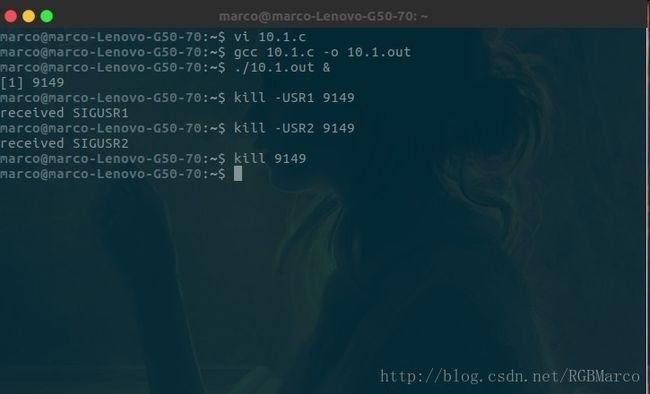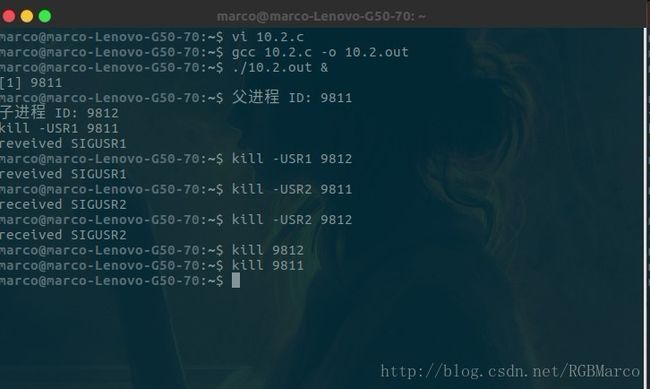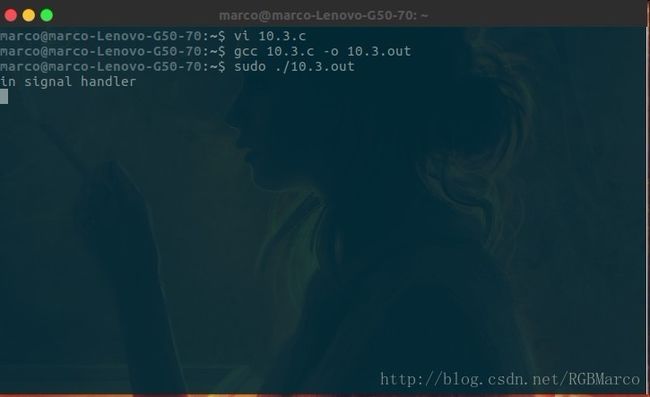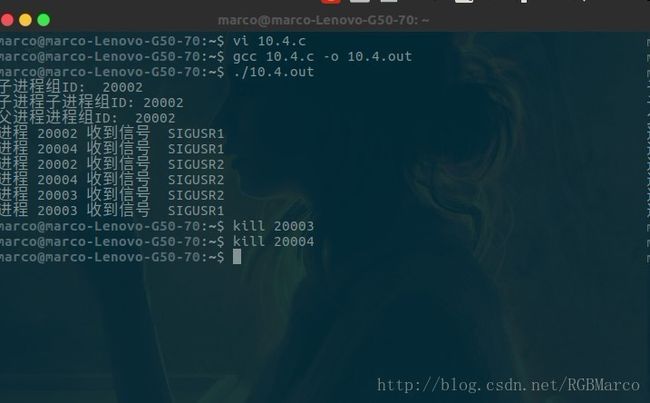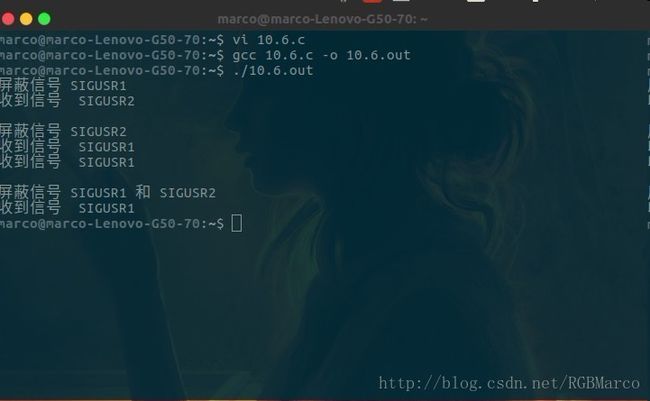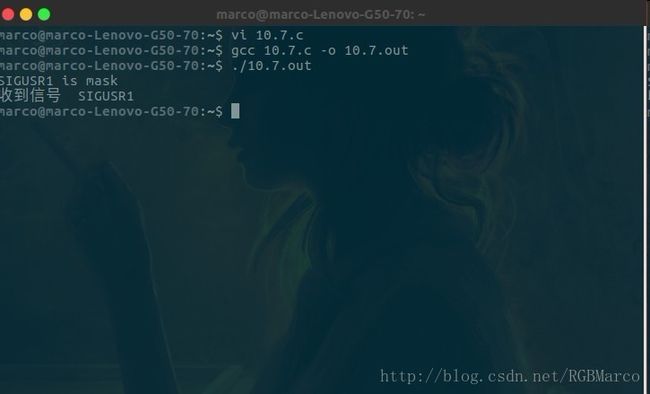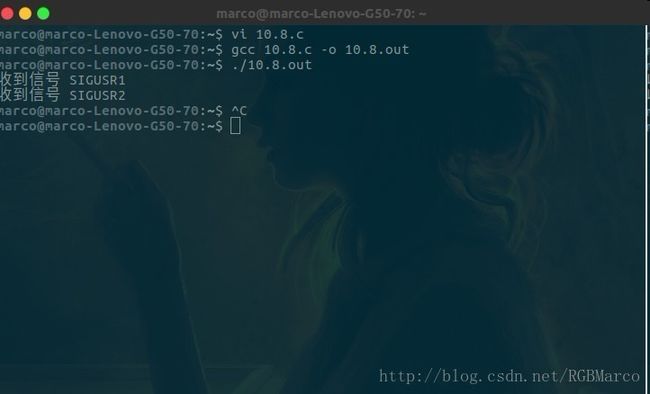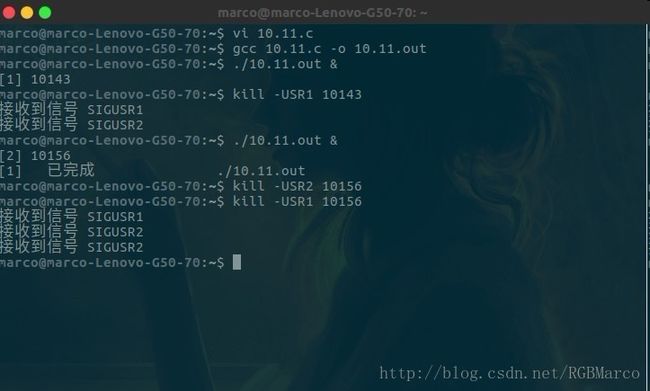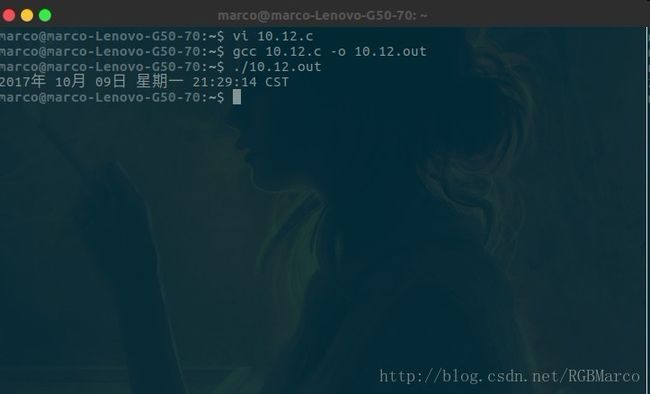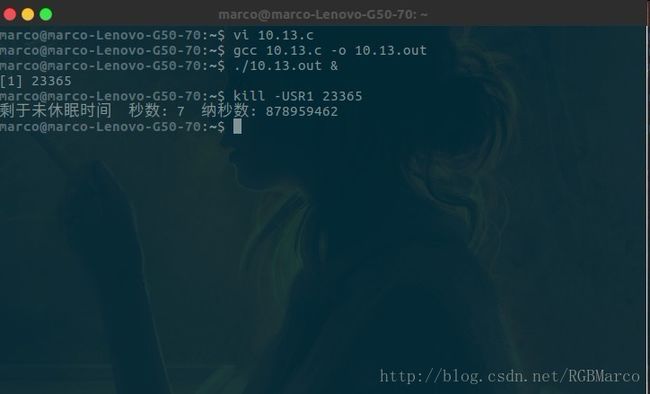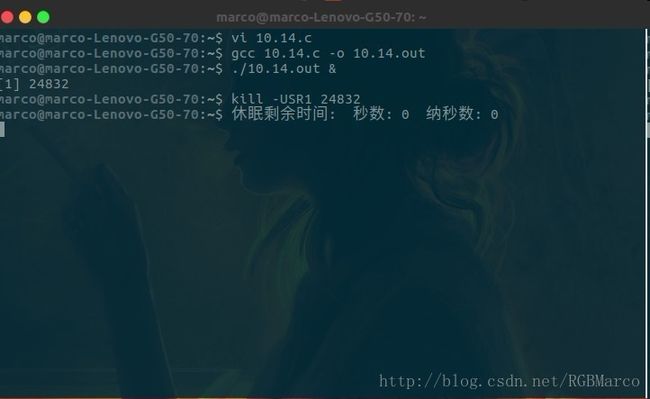APUE第十章学习笔记
1.信号
/*****************************************
信号处理方式:
(1):忽略此信号。(SIGKILL 和 SIGSTOP信号不能被忽略)
(2):捕捉信号
(3):执行系统默认动作
*****************************************/
/*****************************************
包含头文件 #include <signal.h>
函数原型: void (*signal(int signo,void(*func)(int)))(int);
函数说明:signo是信号名,func的值是常量 SIG_IGN(忽略) SIG_DEL(系统默认动作) 或 当接到此信号后要调用的函数地址
返回值:若成功,返回以前的信号处理配置,若出错,返回SIG_ERR
*****************************************/
/****************************************
exec函数将原先设置为要捕捉的信号都更改为默认动作,其他信号的状态则不变(一个进程原先要捕捉的信号,当其执行一个新程序后,就不能再不捕捉了)
子进程会继承父进程信号处理方式
*****************************************/vi 10.1.c
#include vi 10.2.c
include
#include 2.可重入函数
/*****************************************
可重入函数: 在信号处理程序中保证调用安全的函数,这些函数是可重入的并称为异步信号安全的
不可重入函数一般有以下性质:
(1):已知它们使用静态数据结构
(2):它们调用malloc和free
(3):它们是标准I / O函数
*****************************************/
/*****************************************
当一个信号产生时,内核在进程表以某种形式设置一个标志,此时为向进程递送一个信号,在信号产生和递送之间的时间间隔内,称信号是未决的
如果进程产生了一个阻塞的信号,而且对该信号的动作是系统默认动作或捕捉该信号,则为该进程将此信号保持为未决状态,直到该进程对此信号解除了阻塞,或者将对此信号动作改成忽略
*****************************************/vi 10.3.c
#include 函数 kill 和 raise
/********************************************************
包含头文件: #include <signal.h>
函数原型: int kill(pid_t pid,int signo);
int raise(int signo);
函数说明: kill将信号发送给进程或进程组
raise函数则允许进程自身发送信号
kill: (1):若pid > 0,则发送signo至进程pid
(2): 若pid == 0,则发送至同一进程组的所有进程(不包括实现的系统进程集)
(3): 若 pid < 0,将该信号发送给进程组等于pid绝对值的所有进程(不包括实现的系统进程集)
(4): 若pid == -1,将该信号发送给发送进程有权限发送的所有进程(不包括实现的系统进程集)
raise: 允许进程向自身发送信号
返回值:若成功,返回0,若出错,返回-1
***********************************************************/vi 10.4.c
#include /*******************************************************
包含头文件: #include <unistd.h>
函数原型: unsigned int alarm(usigned int seconds);
函数说明: 参数seconds的值是产生信号SIGALRM需要经过时钟秒数
每个进程只能有一个闹钟时间.如果在调用alarm时,之前已为该进程注册的闹钟时间还没有超时,则将该闹钟时间的余留值作为本次alarm函数调用的值返回,以前
注册的闹钟被新值代替
返回值: 0 或 以前设置的闹钟时间的余留秒数
********************************************************/
/*******************************************************
包含头文件: #include <unistd.h>
函数原型: int pause(void);
函数说明:使调用进程挂起直至捕捉到一个信号
返回值: -1,errno设置为 EINTR
********************************************************/vi 10.5.c
#include vi 10.5.1.c
#include 3.信号集
/*******************************************************
包含头文件: #include <signal.h>
函数原型: int sigemptyset(sigset_t *set);
int sigfillset(sigset_t *set);
int sigaddset(sigset_t *set,int signo);
int sigdelset(sigset_t *set,int signo);
int sigismember(const sigset_t *set,int signo);
函数说明: sigemptyset 清除所有信号
sigfillset 初始化所有信号
sigaddset 增加特定信号
sigdelset 删除特定信号
sigismember 判断特定信号是否存在于信号集
返回值: sigemptyset sigfillset sigaddset sigdelset
若成功,返回0,若出错,返回-1
sigismember 返回值: 若真,返回 1,若假,返回0
*******************************************************/
/**********************************************************
包含头文件: #include <signal.h>
函数原型: int sigprocmask(int how,const sigset_t* restrict set,sigset_t *restrict oset);
函数说明:若set为空,则进程信号屏蔽字则通过oset返回
若set非空,则通过how来指示如何修改当前信号屏蔽字
how: SIG_BLOCK 取set 和 oset并集作为当前信号屏蔽字
SIG_UNBLOCK 取set 和 oset并集并解除set作为当前信号屏蔽字
SIG_SETMASK 将set值作为当前信号屏蔽字
注:在调用sigprocmask后如果有任何未决的,不再阻塞的信号,则在sigprocmask返回前,至少将其中之一递送给该进程
***************************************************/
vi 10.6.c
#include /*****************************************
包含头文件: #include <signal.h>
函数原型: int sigpending(sigset_t *set);
函数说明: 返回信号集,对于调用进程而言,其中的信号是阻塞不能递送的,因而也一定是当前未决的.
返回值: 若成功,返回0,若出错,返回-1
*****************************************/vi 10.7.c
#include 4.sigaction函数
/*****************************************
包含头文件: #include <signal.h>
函数原型: int sigaction(int signo,const struct sigaction *restrict act,struct sigaction * restrict oact);
函数说明:参数signo是要检测或修改其具体动作的信号编号,若act非空,则修改其动作,如果oact非空,则系统由oact返回该信号的上一个动作
返回值:若成功,返回0,若失败,返回-1
strcut sigaction
{
void (*sa_handler)(int) ; //信号处理函数的地址
sigset_t sa_mask; //增加需要阻塞的信号
int sa_flags; //可选标志
void (*sa_sigaction)(int,siginfo_t *,void *);
//可替代信号处理程序
}
struct siginfo
{
int si_signo; //信号编号
int si_errno; //错误标志
int si_code; //可添加的代码
pid_t si_pid; //传送进程ID
uid_t si_uid; //传送进程实际用户ID
void *si_addr; //造成错误的地址
int si_status; //退出值或信号值
union sigval si_value; //应用程序特殊值
/* ………….. */
};
union sigval
{
int sival_int;
void* sival_ptr;
};
*****************************************/vi 10.8.c
#include vi 10.9.c
#include 4.sigsetjmp 和 siglongjmp函数
/**********************************************************
包含头文件: #include <setjmp.h>
函数原型: int sigsetjmp(sigjmp_buf env,int savemask);
函数说明: 进行非局部转移并恢复所保存信号屏蔽字
返回值:若直接调用,返回0;若从siglongjmp调用返回,则返回非0
void siglongjmp(sigjmp_buf env,int val);
*********************************************************/5.sigsuspend函数
#include 6.函数system
vi 10.12.c
#include 7.nanosleep
/**********************************************************
包含头文件: #include <time.h>
函数原型: int nanosleep(const struct timespec *reqtp,struct timespec *remtp);
函数说明:挂起调用进程,直到要求时间超时或某个信号中断了该函数,reqtp指向休眠长度,remtp未休眠完时间长度
返回值:若休眠到要求的时间,返回0,若出错,返回-1
**********************************************************/
/***********************************************************
包含头文件: #include <time.h>
函数原型: int clock_nanosleep(clockid_t clock_id,
int flags,const struct timespec* reqtp,struct timespec* remtp);
函数说明: flags为0表示休眠时间是相对的,表示休眠reqtp时间,flags为 TIMER_ABSTIME,表示休眠时间是绝对的,表示休眠到reqtp
**********************************************************/vi 10.13.c
#include vi 10.14.c
#include 8.sigqueue函数
/***********************************************************
包含头文件: #include <signal.h>
函数原型: int sigqueue(pid_t pid,int signo,const union sigval value);
函数说明:将信号发给单个进程,并附带value所传递值
***********************************************************/vi 10.15.c
#include 